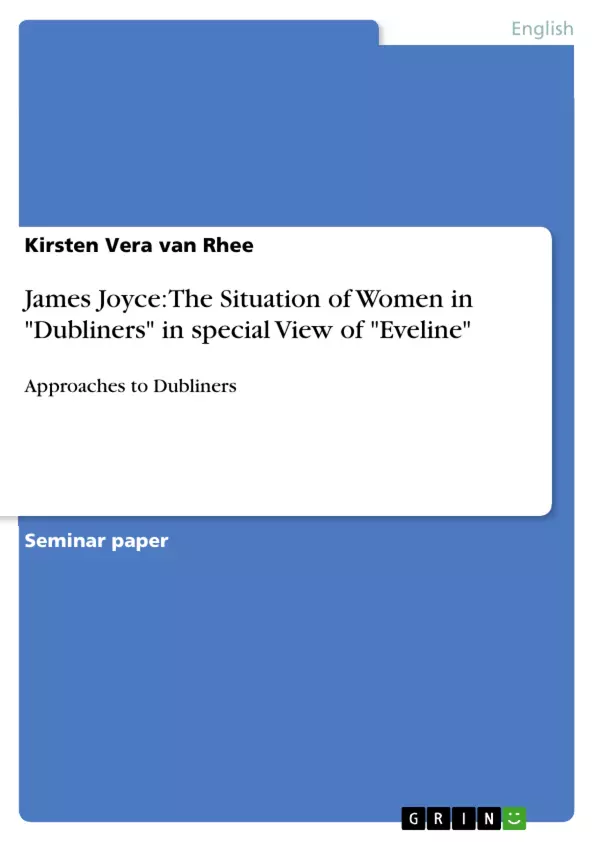1. Introduction.
When James Joyce had finally completed Dubliners in 1908,
he himself considered his first work of fiction, a collection
of fifteen short stories, to be a scrupulously realistic portrait
of the Irish middle-class society of his time - a "looking-glass"
in which the people of Dublin could see themselves and their paralysis. To introduce the book's major theme of paralysis,
Joyce wrote the following critical commentary on Dubliners :
My intention was to write a chapter of moral history of my
own country and I chose Dublin for the scene because that city seemed to me the centre of paralysis. I have tried to present
it to the indifferent public under four of its aspects: childhood, adolescence, maturity and public life. The stories are arranged
in this order. I have written it for the most part in a style of scrupulous meanness...
All of the characters in Dubliners are embedded in life's chronology, ranging from young to old and everyone is a typical portrayal of the ordinary people caught in everyday situations.
They all have to endure the progressive diminution of life and vitality in the morbid and constrictive society of Dublin, in
which human relations become distorted and escape seems to be impossible. In Dubliners, men and women are equally depicted as victims of their social and economic milieu, but the realistic picture Joyce drew of the situation of his female characters
shows that women were even more affected by the narrow confines
of a rather male dominant society.
This paper is an attempt to picture Joyce's female Dubliners
in their oppressive environment, mainly focusing on Joyce's
"Eveline" as an all-encompassing representative of women's
suffering in nineteenth-century Dublin.
Inhaltsverzeichnis (Table of Contents)
- Introduction
- The social and economic conditions of women in the Irish society of Joyce's time - a brief survey.
- The situation of women in Dubliners
- The unhappy marital life
- "Grace" and "A Painful Case"
- The unhappy celibate life in "The Sisters"
- Maternal domination in "A Mother"
- The unhappy marital life
- "Eveline"
- Eveline's standard of living
- Maternal and paternal domination
- Eveline and religious domination
- The lack of love
- Conclusion
Zielsetzung und Themenschwerpunkte (Objectives and Key Themes)
This paper aims to explore the portrayal of women in James Joyce's "Dubliners," specifically focusing on the short story "Eveline." It seeks to understand how Joyce depicts the social and economic conditions of women in early 20th century Dublin and how these factors contribute to the characters' feelings of paralysis and lack of agency.
- The social and economic realities of women in Dublin in the early 20th century
- The impact of societal expectations and religious influence on women's lives
- The themes of paralysis and lack of agency in Joyce's female characters
- The role of family dynamics and relationships in shaping the lives of women in Dubliners
- The specific case of "Eveline" as a representative of the plight of women in Joyce's Dublin
Zusammenfassung der Kapitel (Chapter Summaries)
The paper begins by examining the social and economic conditions that shaped the lives of women in early 20th century Dublin, emphasizing the limited opportunities and expectations placed upon them. It then analyzes the representation of women in "Dubliners" more broadly, exploring themes of unhappy marriages, celibacy, and maternal domination.
A significant portion of the paper is dedicated to a detailed analysis of "Eveline," exploring her standard of living, the influence of family dynamics, religious beliefs, and the lack of love she experiences. This analysis highlights how Eveline's situation embodies the broader challenges faced by women in Joyce's Dublin.
Schlüsselwörter (Keywords)
This paper focuses on the key themes of gender roles, societal constraints, religious influence, and paralysis in James Joyce's "Dubliners," with a specific focus on the character of Eveline.
- Quote paper
- Kirsten Vera van Rhee (Author), 1994, James Joyce: The Situation of Women in "Dubliners" in special View of "Eveline", Munich, GRIN Verlag, https://www.grin.com/document/174842



